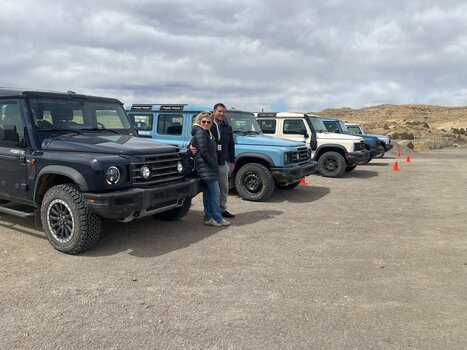Brilliant post AWo.Differences between the Grenadier and the G:
The predecessor of the latest G has rigid axles which produce resistance against articulation. They use trailing arms for the front and rear axle which are mounted at three points, one at the chassis and two at the axle, as you can see here:
View attachment 7809070
View attachment 7809071
They "do not like" to entangle. That is good for road performance as this is self stabilizing. Just take a G onto a lifting plattform and put a transmission jack under one of the rear wheels and pump it up. You can see that after a few centimeters of lifting the other side follows. Same at the front axle. The Defender has the same principle, but only at the front axle. The G compensates the lack of entanglement with its diff locks. You can see here, why it doesn't entagle well:
View attachment 7809073
The Grenadier uses Four-Link-Axles in the front and rear. It is quite common at rear axles and the latest G-Model uses Four-Link-Axles in the back, as well. It is not common for front axles. The only other car I know which has (very short) Four-Links at the front axle is the Jeep Wrangler, which is the reference in offroad driving today.
View attachment 7809075
That leads to very easy entanglement. It is easy for the axle to entangle and follow the terrain (however, diff locks are always the better choice as a you also need ground pressure when the axle ist entangled to get grip. But often the axles entagle but they lack this ground pressure). Easy entanglement with no opposite force leads to poorer road performance than the other concepts, what makes a stabilizer necessary. If you can lock and unlock the stabilizer you have a good compromise.
However, one of the best axle systems is that of the Discovery 2. It is a Watt-System without a Panhard bar. It keeps the axle in the middle which is important for towing and fast driving on bad tracks. It entangles very well and holds the axle precisely in the middle.
View attachment 7809072
But you can't use such a system in the front as it is necessary that the axle can move sideways (caused by the Panhard bar). Otherwise your steering wheel would turn heavily each time the axle dives in or dives out. The Panhard bar at the rear axle is also a common (small) drawback for towing and (a bigger) drawback for fast driving on bad tracks. The rear axle is important for driving stability. If the car dives in and out at the rear (also caused by a trailer) its rear moves sideways. That could lead to a trailer pushing the rear of the car sideways on bad tracktion roads (wet tarmac or wet leaves on the road for example).
View attachment 7809074
Cheers
AWo
Possibly the best article I have read so far on this forum.




